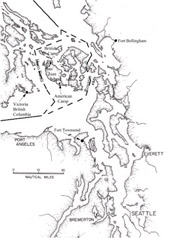
click on image for larger view
The Pig Island War
The Oregon Treaty, signed by Great Britain and the United States in 1846,
established
the boundary west from the Rocky Mountains "to the middle of
the channel which separates the continent
from Vancouver's Island and then
southerly through the middle of said channel and of Fuca's Straits to
the
Pacific Ocean". This left unresolved the exact location of the border through
the channel. The
United States used Haro Straight to the west of San Juan
Island as the border, Great Britain used
Rosario Strait, to the east, as the
border. Thus both sides claimed ownership of San Juan Island. By
1853 the
British had established a presence of San Juan Island in the form of a
Hudson Bay Company
fishing village and Bellevue Farm (a 4,500 acre sheep
ranch). In 1854 a United States customs collector,
Isaac N. Ebey, and his
deputy, Henry Webber, landed on San Juan Island and attempted to collect
duties
from the farm manager - who in turn swore out a warrant for the
deputy's arrest for trespass. Nothing
came of this. In 1855, an American
sheriff, Ellis Barnes with a party of ten armed men landed on San
Juan Island
and rounded up 35 sheep belonging to the farm, for payment of past taxes. In
turn the
Hudson Bay Company submitted a claim for $15,000 in damages.
The United States Secretary of State, William L. Marcy, urged that neither side should
attempt to exercise
exclusive sovereignty and in 1857 a Joint Boundary Commission was formed with
Archibald Campbell as the
head of the American delegation and Royal Navy Captain James C. Prevost in
charge of the British delegation.
The commission met several time in 1857 but came to no settlement.
In 1857 and 1858 two items made the situation worse. First, an Indian uprising in the
Pacific Northwest brought
a stronger U. S. military presence. Second, a gold rush in what is now British
Columbia (then New Caledonia),
led the British to establish the area as a formal colony.
By 1859, 18 Americans had settled on the island. In June, one of them, Lyman A. Cutlar,
shot a pig that was
rooting in his garden. Cutlar offered compensation, but refused to pay the $100 asked
for (the farm manager
claimed the pig was a prize breeder). British authorities approached Cutlar and
told him that he would be
subject to arrest if he did not pay. The new American commander of the U. S.
Military Department of Oregon,
Brigadier General William Selby Harney, visited the island in July and
as a result Company D, of the Ninth
Infantry, was sent from Fort Bellingham. Commanded by Captain George
Pickett, Company D was sent to the
island, to “resist all attempts at interference by British authorities
residing at Vancouver’s Island, by intimidation
or force…”. The British responded by sending three
warships mounting a total of 61 guns and nearly a thousand
men, including a contingent of Royal Marines.
A meeting between Captain Picket and Captain Hornby, during
which Captain Hornby suggested joint occupancy,
did not resolve the issue, Captain Picket stating that he
could not agree to any joint occupancy with out
orders from General Harney. General Harney responded by
sending additional American troops, including
Companies A, C, and I of the Fourth Infantry regiment (Company
I from Fort Townsend and Companies A and
C from Fort Steilacoom. By August 1859 the American troops
numbered 461 and the British had five war
ships with 167 guns, and more than two thousand crew.
Because of the time it took news to travel, the United States government did not learn
of the confrontation until
September. In spite of poor health, Chief of the Army, General Winfield
Scott, paid a personal visit to the Pacific
Northwest. Meeting in October, General Scott again put
forward Captain Hornby’s offer of joint occupation.
General Scott also reduced the American presence
to one company, Company C of the Fourth Infantry, under
the command of Captain Lewis C. Hunt. In March
of 1860, Admiral Baynes, in charge of the British forces,
finally received orders that allowed him to
land troops on the island. A Royal Marine troop, numbering 84, under
the command of Captain George
Bazalgette, landed and set up camp on the opposite end of the island. General
Harney, known for
frequent insubordination, a foul temper, and a vulgar tongue was furious (he had not been told
of the
joint occupancy agreement). In an act of insubordination, General Harney sent Company D, under Pickett,
back to San Juan Island to relieve Captain Hunt. When word of this reached Washington, General Harney
was
ordered to turn command over to the officer next in rank and to report, without delay, to the
Secretaries of War
and of State. Although repremanded by the Secretary of War, General
Harney was given command of the
Department of the West. He was recalled from this post in 1861 after
he reported difficulties with his officers.
He retired in 1863 holding no further commands.
Pickett left his command in June of 1861 and soon after resigned his commission
in the U. S. Army. After traveling
to Virginia, he was appointed a Colonel in the army being formed by
the Confederate States of America.
The border remained in dispute for the next ten years. Finally the United States and
Great Britain turned the matter
over to Kaiser Wilhelm I of Germany for arbitration. In October of
1872 he ruled in favor the United States and the
boundary was drawn through the Haro Strait. In November
1872 the British withdrew the garrison of Royal Marines.
Link to San Juan Island web site.